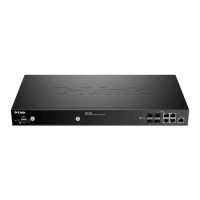D-Link DWC-2000 User Manual 147
Section 5 - Advanced Network Conguration
QoS Conguration
In a typical controller, each physical port consists of one or more queues for transmitting packets on the attached
network. Multiple queues per port are often provided to give preference to certain packets over others based on
user‐dened criteria. When a packet is queued for transmission in a port, the rate at which it is serviced depends
on how the queue is congured and possibly the amount of trac present in the other queues of the port. If a
delay is necessary, packets get held in the queue until the scheduler authorizes the queue for transmission. As
queues become full, packets have no place to be held for transmission and get dropped by the controller.
QoS is a means of providing consistent, predictable data delivery by distinguishing between packets that have
strict timing requirements from those that are more tolerant of delay. Packets with strict timing requirements
are given “special treatment” in a QoS capable network. With this in mind, all elements of the network must be
QoS‐capable. The presence of at least one node which is not QoS‐capable creates a deciency in the network
path and the performance of the entire packet ow is compromised.
QoS Priority
Conguring QoS Priority settings is a 3-step process:
1. Enable QoS mode (next page), and
2. Dene the Trust Mode on each port (refer to “Dening DSCP and CoS on each port” on page 150)
3. Dene the DHCP or COS settings (refer to “Conguring DSCP Priority” on page 152 or “Conguring
802.1p Priority” on page 151).

